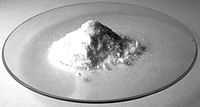Zinc nitrate
| Zinc nitrate | |
|---|---|
 | |
 | |
| IUPAC name Zinc nitrate | |
| Identifiers | |
| CAS number | 7779-88-6 19154-63-3 (tetrahydrate) 10196-18-6 (hexahydrate) |
| PubChem | 24518 |
| ChemSpider | 22926 |
| EC number | 231-943-8 |
| UN number | 1514 |
| RTECS number | ZH4772000 |
| Jmol-3D images | {{#if:[N+](=O)([O-])[O-].[N+](=O)([O-])[O-].[Zn+2]|Image 1 |
| |
| |
| Properties | |
| Molecular formula | Zn(NO3)2 |
| Molar mass | 189.36 g/mol (anhydrous) 297.49 g/mol (hexahydrate) |
| Appearance | colorless, deliquescent crystals |
| Density | 2.065 g/cm3 (hexahydrate) |
| Melting point | 110 °C (anhydrous) 45.5 °C (trihydrate) 36.4 °C (hexahydrate) |
| Boiling point | ~125 °C, decomp (hexahydrate) |
| Solubility in water | 327 g/100 mL, 40 °C (trihydrate) 184.3 g/100 ml, 20 °C (hexahydrate) |
| Solubility | very soluble in alcohol |
| Hazards | |
| MSDS | ICSC 1206 |
| EU Index | Not listed |
| Main hazards | Oxidant, may explode on heating |
| Flash point | Non-flammable |
| Related compounds | |
| Other anions | Zinc sulfate Zinc chloride |
| Other cations | Cadmium nitrate Mercury(II) nitrate |
| Related compounds | Copper(II) nitrate |
| Except where noted otherwise, data are given for materials in their standard state (at 25 °C (77 °F), 100 kPa) | |
| Infobox references | |
Zinc nitrate is a highly deliquescent substance which is usually prepared by dissolving zinc in nitric acid. It can be used as a mordant in dyeing. An example reaction gives a precipitate of zinc carbonate: Zn(NO3)2 + Na2CO3 → ZnCO3 + 2 NaNO3.
Conditions/substances to avoid are: reducing agents, organic materials, metal powders, heat and flame, cyanides, sodium hypophosphite, tin(IV) chloride, phosphorus, thiocyanates, carbon, and sulfur.
Zinc nitrate is soluble in both water and alcohol. It is a white, crystalline solid.
On heating, it forms zinc oxide, nitrogen dioxide and oxygen. It gives a residue that is yellow when hot and white when cold.
Zinc forms zinc nitrate in reaction with nitric acid, but depending on the concentration of the acid it reacts differently:
Zn + 2HNO3 dil. → Zn(NO3)2 + H2
4Zn + 10HNO3 conc. → 4Zn(NO3)2 + NH4NO3 + 3H2O
References
| ||||||||||||
| HNO3 | He | |||||||||||||||||
| LiNO3 | Be(NO3)2 | B(NO3)3 | C | N | O | F | Ne | |||||||||||
| NaNO3 | Mg(NO3)2 | Al(NO3)3 | Si | P | S | ClONO2 | Ar | |||||||||||
| KNO3 | Ca(NO3)2 | Sc(NO3)3 | Ti | V | Cr(NO3)3 | Mn(NO3)2 | Fe(NO3)3 | Co(NO3)2, Co(NO3)3 | Ni(NO3)2 | Cu(NO3)2 | Zn(NO3)2 | Ga(NO3)3 | Ge | As | Se | Br | Kr | |
| RbNO3 | Sr(NO3)2 | Y | Zr | Nb | Mo | Tc | Ru | Rh | Pd(NO3)2 | AgNO3 | Cd(NO3)2 | In | Sn | Sb | Te | I | Xe | |
| CsNO3 | Ba(NO3)2 | Hf | Ta | W | Re | Os | Ir | Pt | Au | Hg2(NO3)2, Hg(NO3)2 | Tl(NO3)3 | Pb(NO3)2 | Bi(NO3)3 | Po | At | Rn | ||
| Fr | Ra | Rf | Db | Sg | Bh | Hs | Mt | Ds | Rg | Cn | Uut | Fl | Uup | Lv | Uus | Uuo | ||
| ↓ | ||||||||||||||||||
| La | Ce | Pr | Nd | Pm | Sm | Eu | Gd(NO3)3 | Tb | Dy | Ho | Er | Tm | Yb | Lu | ||||
| Ac | Th | Pa | UO2(NO3)2 | Np | Pu | Am | Cm | Bk | Cf | Es | Fm | Md | No | Lr | ||||
Zinc + nitric acid -> zinc nitrate + hydrogen